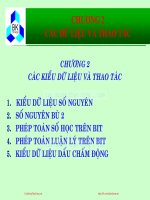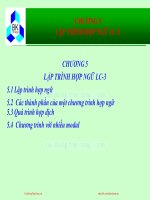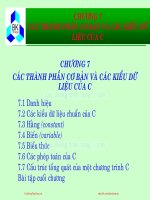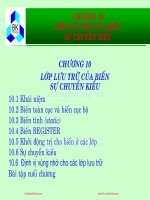he thong may tinh va ngon ngu c nguyen phuc khai 06 lc3 assembly cuuduongthancong com
Bạn đang xem bản rút gọn của tài liệu. Xem và tải ngay bản đầy đủ của tài liệu tại đây (498.86 KB, 29 trang )
.c
om
du
o
ng
th
an
co
ng
LC-3
Assembly Language
cu
u
(Textbook Chapter 7)"
CuuDuongThanCong.com
/>
• Machine language - binary"
ng
0001110010000110
.c
om
Assembly and assembler"
R6, R2, R6
an
ADD
co
• Assembly language - symbolic"
; increment index reg.
du
o
ng
th
• Assembler is a program that turns symbols into
machine instructions."
cu
u
– ISA-specific: close correspondence between symbols
and instruction set"
• mnemonics for opcodes"
• labels for memory locations"
CMPE12 – Fall 2011 – Joel Ferguson"
CuuDuongThanCong.com
6 - 2"
/>
du
o
ng
th
an
co
Instructions (we have seen most of them)!
Comments"
Labels"
Declarations"
Assembler directives and trap codes"
cu
u
•
•
•
•
•
ng
.c
om
Syntax of LC-3 assembly:
Language elements"
Case is ignored."
CMPE12 – Fall 2011 – Joel Ferguson"
CuuDuongThanCong.com
6 - 3"
/>
.c
om
Instructions"
an
co
ng
• One instruction or declaration per line"
u
mandatory!
cu
optional!
du
o
ng
th
LABEL OPCODE OPERANDS ; COMMENTS!
CMPE12 – Fall 2011 – Joel Ferguson"
CuuDuongThanCong.com
6 - 4"
/>
.c
om
Opcodes and Operands"
• Opcodes"
ng
– reserved symbols that correspond to LC-3 instructions"
co
– listed in Appendix A (ex: ADD, AND, …)"
th
an
• Operands"
cu
u
du
o
ng
– Registers: Rn, where n is the register number"
– Immediate numbers: # (decimal), x (hex), or b (binary)"
– Labels: symbolic names of memory locations"
– Operands are separated by spaces, tabs, or commas"
– Their number, order, and type correspond to the instruction
format"
CMPE12 – Fall 2011 – Joel Ferguson"
CuuDuongThanCong.com
6 - 5"
/>
.c
om
Data types"
an
co
ng
LC-3 has 2 basic data types"
• Integer"
• Character"
cu
u
du
o
ng
th
Both are 16 bits wide (a word), though a
character is only 8 bits in size."
CMPE12 – Fall 2011 – Joel Ferguson"
CuuDuongThanCong.com
6 - 6"
/>
.c
om
Comments"
th
an
co
ng
– Anything on a line after a semicolon is a comment"
– Comments are ignored by assembler"
– Used by humans to document/understand programs"
– Tips for useful comments:"
cu
u
du
o
ng
• avoid restating the obvious, as “decrement R1”"
• provide additional insight, as in “accumulate product in R6”"
• use comments to separate pieces of program"
CMPE12 – Fall 2011 – Joel Ferguson"
CuuDuongThanCong.com
6 - 7"
/>
.c
om
Labels"
th
an
co
ng
• Placed at beginning of line"
• Assign a symbolic name to their line (its address)"
• Symbolic names used to identify memory locations.
Two kinds:"
du
o
ng
– Location of target of a branch or jump"
– Location of a variable for loading and storing"
cu
u
• Can be 1-20 characters in size"
CMPE12 – Fall 2011 – Joel Ferguson"
CuuDuongThanCong.com
6 - 8"
/>
Assembler directives"
.c
om
• Directives or psuedo-ops give information to the
th
an
co
ng
assembler."
• Not executed by the program"
• All directives start with a period ʻ.ʼ"
Description!
ng
Directive!
Where to start in placing things in memory"
.FILL
Declare a memory location (variable)"
.BLKW
Declare a group of memory locations (array)"
.END
u
cu
.STRINGZ
du
o
.ORIG
Declare a group of characters in memory (string)"
Tells assembly where your program source ends"
CMPE12 – Fall 2011 – Joel Ferguson"
CuuDuongThanCong.com
6 - 9"
/>
.c
om
.ORIG
ng
th
an
co
ng
• Tells simulator where to put your code in memory
(starting location)"
• Only one .ORIG allowed per program module"
• PC is set to this address at start up"
• Similar to the main() function in C"
du
o
• Example: the standard convention is"
u
.orig
cu
•
x3000"
CMPE12 – Fall 2011 – Joel Ferguson"
CuuDuongThanCong.com
6 - 10"
/>
.c
om
.FILL
th
an
co
ng
• Declaration and initialization of variables"
• One declaration per line"
• Always declaring words"
• Examples: "
ng
.FILL
.FILL
.FILL
.FILL
du
o
cu
u
flag
counter
letter
letters
x0001"
x0002"
x0041
x4241"
CMPE12 – Fall 2011 – Joel Ferguson"
CuuDuongThanCong.com
6 - 11"
/>
.FILL
In C!
cu
u
du
o
ng
co
an
ng
Where type is"
int " (integer)"
char " (character)"
float (floating-point)"
.c
om
!varname;!
In LC-3!
varname
th
"type !
.FILL value!
• value is required (initialize)"
• type is only 16-bit integer"
CMPE12 – Fall 2011 – Joel Ferguson"
CuuDuongThanCong.com
6 - 12"
/>
.BLKW
th
an
;set aside 3 locations
.BLKW
3
co
ng
.c
om
• Reserves (and initializes) a sequence of
contiguous memory locations (arrays)"
• Examples:"
du
o
ng
;set aside 1 location and label it
Bob .BLKW
1
cu
u
; set aside 7 locations,
; label them, and init them all to 4
Num .BLKW
7
#4
CMPE12 – Fall 2011 – Joel Ferguson"
CuuDuongThanCong.com
6 - 13"
/>
.STRINGZ
x0048
.c
om
x0065
ng
.STRINGZ “Hello World!”
cu
u
du
o
hello
th
an
co
ng
• Declare a string of characters"
• Automatically terminated with x0000"
• Example:"
CMPE12 – Fall 2011 – Joel Ferguson"
CuuDuongThanCong.com
6 - 14"
/>
.c
om
.END
cu
u
du
o
ng
th
an
co
ng
• Tells the assembler where your program ends"
• Only one .END allowed in your program module"
• Thatʼs where the assembler stops assembling, NOT
where the execution stops!"
CMPE12 – Fall 2011 – Joel Ferguson"
CuuDuongThanCong.com
6 - 15"
/>
TRAP
.c
om
(System Calls)"
co
ng
Very tedious and dangerous for a programmer to deal
with I/O. "
th
an
This is why we like to have an OS. "
du
o
ng
Need an instruction to get its attention."
cu
u
Use the TRAP instruction and a trap vector."
CMPE12 – Fall 2011 – Joel Ferguson"
CuuDuongThanCong.com
6 - 16"
/>
Trap Service Routines
x20
GETC
x21
OUT
Read a character from console into R0, not echoed. "
an
Write the character in R0[7:0] to console."
x22
th
Write string of characters to console. Start with
character at address contained in R0. Stops when
0x0000 is encountered."
PUTSP
x25
Print a prompt to console and read in a single character
into R0. Character is echoed."
du
o
u
IN
cu
x24
ng
PUTS
x23
Usage & Result!
ng
Assembler
Name!
co
Trap
Vector!
.c
om
The LC-3 assembler provides “pseudo-instructions” for
each trap code, so you donʼt have to remember them."
HALT
Write a string of characters to console, 2 characters per
address location. Start with characters at address in
R0. First [7:0] and then [15:0]. Stops when 0x0000 is
encountered."
Halt execution and print message to console."
CMPE12 – Fall 2011 – Joel Ferguson"
CuuDuongThanCong.com
6 - 17"
/>
To print a character!
Trap
Examples"
.c
om
; the char must be in R0[7:0]"
TRAP!x21 !!
ng
or"
th
an
co
OUT!
du
o
ng
To read in a character!
TRAP!x25
"
" "
HALT!
"or"
""
cu
u
; will go into R0[7:0], !
; no echo.!
TRAP!x20!
To end the program
"
or"
GETC!
CMPE12 – Fall 2011 – Joel Ferguson"
CuuDuongThanCong.com
6 - 18"
/>
.c
om
ng
co
an
th
ng
x0000
x0000
x0007
x0003
du
o
Res
Zero
M0
M1
Simple LC-3
program"
u
Done
x3000
R2, Zero
R0, M0
R1, M1
Done
R2, R2, R0
R1, R1, -1
Loop
R2, Res
cu
Loop
.ORIG
LD
LD
LD
BRz
ADD
ADD
BR
ST
HALT
.FILL
.FILL
.FILL
.FILL
.END
CMPE12 – Fall 2011 – Joel Ferguson"
CuuDuongThanCong.com
6 - 19"
/>
The assembly process"
th
an
co
ng
.c
om
• Convert assembly language file (.asm)
into an executable file (.obj) for the LC-3 simulator."
cu
u
du
o
ng
• First Pass:"
– scan program file"
– find all labels and calculate the corresponding
addresses - the symbol table!
• Second Pass:"
– convert instructions to machine language, using
information from symbol table"
CMPE12 – Fall 2011 – Joel Ferguson"
CuuDuongThanCong.com
6 - 20"
/>
First Pass: The Symbol Table"
co
ng
.c
om
1. Find the .ORIG statement,
which tells us the address of the first instruction."
• Initialize Location Counter (LC), which keeps track of the
current instruction."
du
o
ng
th
an
2. For each non-empty line in the program:"
a) If line contains a label, add label and LC to symbol table."
b) Increment LC."
– NOTE: If statement is .BLKW or .STRINGZ,
increment LC by the number of words allocated."
cu
u
3. Stop when .END statement is reached."
NOTE: A line with only a comment is considered an empty line."
CMPE12 – Fall 2011 – Joel Ferguson"
CuuDuongThanCong.com
6 - 21"
/>
Practice: Symbol Table
.c
om
.ORIG x3000
LD
R2, Zero
LD
R0, M0
LD
R1, M1
; begin multiply
Loop
BRz
Done
ADD
R2, R2, R0
ADD
R1, R1, #-1
BR
Loop
; end multiply
Done
ST
R2, Result
HALT
Result .FILL x0000
Zero
.FILL x0000
M0
.FILL x0007
M1
.FILL x0003
.END
an
Address
cu
u
du
o
ng
th
Symbol
co
ng
Build the symbol table for the
multiply program:
CMPE12 – Fall 2011 – Joel Ferguson"
CuuDuongThanCong.com
6 - 22"
/>
.c
om
2nd Pass: Generating Machine Language"
an
co
ng
• For each executable assembly language statement,
generate the corresponding machine language instruction."
– If operand is a label,
look up the address from the symbol table."
cu
u
du
o
ng
th
• Potential problems:!
– Improper number or type of arguments"
• ex: "NOT !R1,#7
!ADD !R1,R2!
– Immediate argument too large"
• ex: "ADD !R1,R2,#1023!
– Address (associated with label) more than 256 from
instruction"
• canʼt use PC-relative addressing mode"
CMPE12 – Fall 2011 – Joel Ferguson"
CuuDuongThanCong.com
6 - 23"
/>
The LC-3 Assembler"
cu
u
du
o
ng
th
an
co
ng
.c
om
• Using “assemble” (Unix) or LC3Edit (Windows),
generates several different output files."
CMPE12 – Fall 2011 – Joel Ferguson"
CuuDuongThanCong.com
6 - 24"
/>
Multiple Object Files"
du
o
ng
th
an
co
ng
.c
om
• An object file is not necessarily a complete program."
– system-provided library routines"
– code blocks written by multiple developers"
• For LC-3 simulator, can load multiple object files into
memory, then start executing at a desired address."
– system routines, such as keyboard input, are loaded
automatically"
cu
u
• loaded into “system memory,” below x3000"
• user code should be loaded between x3000 and xFDFF"
– each object file includes a starting address"
– be careful not to load overlapping object files"
CMPE12 – Fall 2011 – Joel Ferguson"
CuuDuongThanCong.com
6 - 25"
/>









